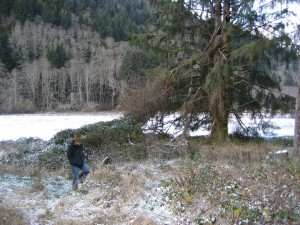Here we are in the first week of the new year… a year that is a very big one for us. Settle in, this is going to be a long post. This year, Emily and I are farming.
We came to this decision after our two years of Peace Corps service in Guatemala. We saw firsthand what happens when the food system fails; if civil unrest, economic downturn, or natural disaster interrupts the fragile web of food distribution, people starve. Americans tend to think themselves immune to these dangers, but recent history proves that is illusionary: hurricane Katrina in the south and landslides in Oregon have both left people hungry within recent memory.
But the acute discomfort of a short-term food failure is only the visible part of a much larger danger. In Guatemala, poverty and civil inequality leave millions of families without regular access to the quality and quantity of food needed to ensure their children’s health. Chronically hungry people are more susceptible to disease, have less strength to work, and score poorly in school. In younger children, hunger leads to irreparable developmental damage. We saw shocking examples of this every day in the Peace Corps, but came to realize that hunger and nutrition are still problems to be fought at home in the US as well. Our friends who are teachers in low-income areas know it. Our friends who live in Appalachia know it.
“Food Security” is the term used in third-world development circles to describe the economic and technical systems to fight hunger. It’s a complicated problem, but there are some simple things families can, with a little education, do to make their food supply more stable. Simply planting a household garden with the right vegetables can make a big difference! Chronic malnutrition is a little more complicated, especially for Americans. Even in unlikely places like Portland or Chicago, some live in food deserts: locations where poor families who rely on public transportation can’t reach a grocery store in less than 30 minutes of travel. They live off of fast food and convenience store treats that are neither affordable nor nutritious. Being above the poverty line, however, is no guarantee against malnutrition. 20% percent of America’s youth are obese, putting them at risk for diabetes, heart disease, and other complications during their lifetimes- dangers that can all be attributed directly to the food we eat.
The more interested we got in food security, the more we realized that this was our calling. We want to grow our own stable supply of food, to keep our family safe against acute hunger. But we also want to help those around us, to both educate about what safe food really is, as well as make it available to the people who understand its importance. Towards the end of our service in the Peace Corps, we realized that we need to farm.
When we tell people we are starting a farm, most look at us like we’re barking mad; or at the very least, like we’re mildly delusional. “Farming is a dead end. You can’t make a living at it. No one wants to buy organic food. How will you pay the bills? What about your real job?” The thing is, this is something we both believe in, and to be honest, we’re both excited about the adventure of it. We realize that we could fail, but we could fail at anything else in life, too. The best things in life, the things worth working for, are challenging. While we were in Guatemala, we saw firsthand how important food security is. But we also learned how much in life we can live without, how simple and satisfying life can be without some of the extraneous gizmos and trappings of modern American existence. Cable TV, Starbucks lattes, Vera Bradley bags…these things aren’t inherently evil, we just don’t really need or want them.
As for our “lives?” Coming off of our Peace Corps service, we are at a unique point in our existence where we have no material assets, no cash, no jobs, no kids, and no home. But we have a lot of experience, energy, positive attitude, and a hell of a lot motivation. We have friends and family that DO support us, even if they don’t totally understand us. To put a positive spin on “no where to go but up,” this is a unique opportunity to take a shot at something we believe in, regardless of the odds stacked against us.
We’ve spent the last few years researching crop types, planting test beds, analyzing agricultural marketing systems, and interviewing farmers. We’ve won grants, attended seminars, and built a network of friends and resources. We’re ready, if anyone ever was for a project like this.
Two and a half years ago, we started a blog to document the things we experienced as health workers in the highlands of Guatemala. Quite unexpectedly, it connected us to a wonderful community of caring people and facilitated a meaningful, two-way exchange of information and emotional support that really enriched our Peace Corps experience. After some discussion, we’ve decided to do it again. I plan on posting updates at least every week or so on how our farm is progressing. Emily will chime in occasionally as the spirit moves her, because a regular schedule stresses her out. And there will be enough stress in the coming year, without adding any of our own making.



